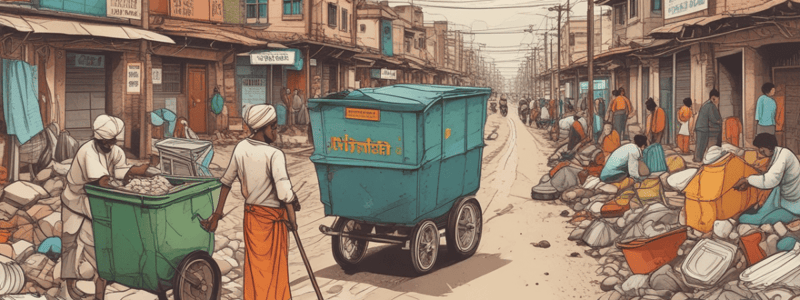Podcast
Questions and Answers
Which of the following is a key feature of Swachh Bharat Mission-U 2.0?
Which of the following is a key feature of Swachh Bharat Mission-U 2.0?
- Promotion of old projects
- Aspirational toilets (correct)
- Elimination of public toilets
- Mandatory open defecation
What is the purpose of providing personal protective equipment under SBM-U 2.0?
What is the purpose of providing personal protective equipment under SBM-U 2.0?
- To improve public awareness
- To ensure the safety of sanitation workers (correct)
- To create more job opportunities
- To reduce the number of informal waste workers
Which principle is not emphasized in the Swachh Bharat Mission-U 2.0?
Which principle is not emphasized in the Swachh Bharat Mission-U 2.0?
- Reduce
- Reuse
- Rebuild (correct)
- Recycle
What type of cities undergo certifications through the Swachh Bharat Mission-U 2.0?
What type of cities undergo certifications through the Swachh Bharat Mission-U 2.0?
How is the funding for SBM-U 2.0 structured?
How is the funding for SBM-U 2.0 structured?
Which of the following is true regarding the construction of toilets under SBM-U 2.0?
Which of the following is true regarding the construction of toilets under SBM-U 2.0?
What is not a focus area of the Swachh Bharat Mission-U 2.0?
What is not a focus area of the Swachh Bharat Mission-U 2.0?
Which type of toilets are included in the SBM-U 2.0 initiatives?
Which type of toilets are included in the SBM-U 2.0 initiatives?
What aspect of sanitation does SBM-U 2.0 particularly address?
What aspect of sanitation does SBM-U 2.0 particularly address?
Which statement is incorrect regarding SBM-U 2.0?
Which statement is incorrect regarding SBM-U 2.0?
Study Notes
Swachh Bharat Mission-U 2.0 Overview
- Launched in 2021, with a focus on North Eastern and Andaman and Nicobar Islands.
- Centrally sponsored scheme aimed at making cities 'Garbage Free'.
- Financial outlay of ₹1,41,600 crores, including ₹36,465 crores from the central government.
- Tenure from 2021-22 to 2025-26, covering all statutory towns in India.
Objectives
- Achieve sustainable solid waste management and reduce single-use plastic usage.
- Ensure sustainable sanitation and proper treatment of used water.
- Raise awareness through citizen outreach campaigns to instill Swachh behavior.
- Develop institutional capacities for effective implementation of interventions.
Key Components
-
Sustainable Solid Waste Management:
- Target of 100% scientific processing of municipal solid waste.
- Includes source segregation, door-to-door collection, and waste processing.
- Establishment of processing facilities for construction and demolition waste.
- Remediation of legacy dumpsites and conversion to green zones.
-
Sustainable Sanitation:
- Maintain Open Defecation Free status in statutory towns.
- Construction of individual latrines, community, and public toilet seats.
- New component for used water management to prevent untreated discharge into the environment.
-
Information, Education, and Communication (IEC):
- Focus on citizen awareness and behavior change communication.
-
Capacity Building:
- Development of institutional skills for effective program execution.
Key Features
- Expansion to include populations migrating from rural to urban settings, with a target of over 3.5 lakh toilets.
- Construction of Material Recovery Facilities and waste processing units aimed at reducing plastic waste.
- Infrastructure projects designed for urban-rural convergence, enhancing resource efficiency.
Additional Features
- Emphasis on new projects and aspirational toilets, especially at tourist hotspots.
- Support for sanitation workers through safety equipment and welfare scheme connections.
- Utilization of reduce, reuse, recycle principles (3Rs).
- Annual certifications for cities achieving Open Defecation Free and Garbage Free status through third-party evaluation.
Mission Outcome
- Focuses on comprehensive management strategies for sanitation and waste, aiming for significant improvements in public health and environmental sustainability.
Incorrect Statement Identification (Homework Question)
- Review provided options to identify the incorrect statement concerning SBM(U) 2.0 based on the mission's features and financial contributions.
Studying That Suits You
Use AI to generate personalized quizzes and flashcards to suit your learning preferences.
Related Documents
Description
Learn about the Swachh Bharat Mission-U 2.0, a centrally sponsored scheme launched in 2021 to make cities garbage-free. It has a financial outlay of ₹1,41,600 crores and aims to achieve sustainable solid waste management and reduce single-use plastic usage.




